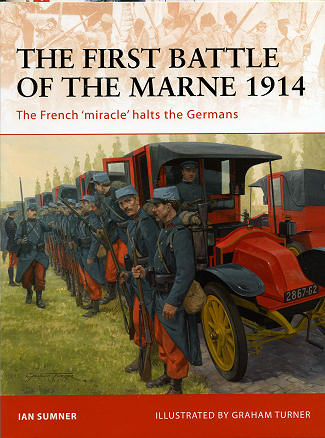 Though
perhaps not realized by most whose interest is in other areas aside from WWI,
the war was almost over a few months after it started. The Germans has pressed
into Belgium and France, driving the French and British forces back towards
Paris. In a matter of weeks, the French were just a breath away from total
defeat, yet it did not happen, and the war would slog on for four more years.
Several things caused this turn of events for the Germans and for the French.
Though
perhaps not realized by most whose interest is in other areas aside from WWI,
the war was almost over a few months after it started. The Germans has pressed
into Belgium and France, driving the French and British forces back towards
Paris. In a matter of weeks, the French were just a breath away from total
defeat, yet it did not happen, and the war would slog on for four more years.
Several things caused this turn of events for the Germans and for the French.
First of all, the German overextended themselves in the rush to Paris, allowing
large sectors to either go un protected or be so thinly occupied as to make
holding on impossible. Secondly, there was little in the way of properly
coordinated attack by the German side of the war by this time, so often plans
were only for a small sector of the front and not on a front wide basis.
This allowed something of a breathing space for the French,
who were able to exploit the weaknesses of the German advance and bring up much
needed reinforcements. Such was the need that the French General in charge of
the defense of Paris, General Gallieni, was able to hire all available French
taxis to take his troops to the front line to bolster the units that were there.
In case you are wondering, the cabbies were paid standard fares for this!
A series of missed opportunities on one side and the ability
to exploit mistakes on the other saved the French from what was nearly
inevitable disaster. Once the German advance was halted, the French dug in and
thus started trench warfare, something that came to symbolize the First World
War. Of course, there is much more to the situation than what I've mentioned as
reputations were made and broken during the weeks of the Marne campaign.
In this book on the first Marne, author Ian Sumner
starts with a preamble of events leading up to the battle, a look at the
commanders of both sides and the men under their command. Then there is an
inspection of the plans of both sides. The 'meat' of the volume is next with the
various stages of the battle, including the incredible movement of men and
equipment needed to perform the assuault and defense. Finally,
introspection on how the battle went, what was learned from it, and how it
affected future events. There is also a look at the battlefield today. All of
this is superbly illustrated with period photographs and the artwork of Graham
Turner.
If you want insight into a pivotal event in the First World
War, or
just a fascinating read, then this is the book for you. I thoroughly enjoyed
reading it and I'm sure you will as well.
February 2011
For more on the complete line of Osprey books,
visit www.ospreypublishing.com. In the US, it is
Osprey Direct at 44-02 23rd St, Suite 219, Long Island City, NY 11101., where you can
get a catalogue of available books.
If you would like your product reviewed fairly and quickly, please contact
me or see other details in the Note to
Contributors.
 Though
perhaps not realized by most whose interest is in other areas aside from WWI,
the war was almost over a few months after it started. The Germans has pressed
into Belgium and France, driving the French and British forces back towards
Paris. In a matter of weeks, the French were just a breath away from total
defeat, yet it did not happen, and the war would slog on for four more years.
Several things caused this turn of events for the Germans and for the French.
Though
perhaps not realized by most whose interest is in other areas aside from WWI,
the war was almost over a few months after it started. The Germans has pressed
into Belgium and France, driving the French and British forces back towards
Paris. In a matter of weeks, the French were just a breath away from total
defeat, yet it did not happen, and the war would slog on for four more years.
Several things caused this turn of events for the Germans and for the French.